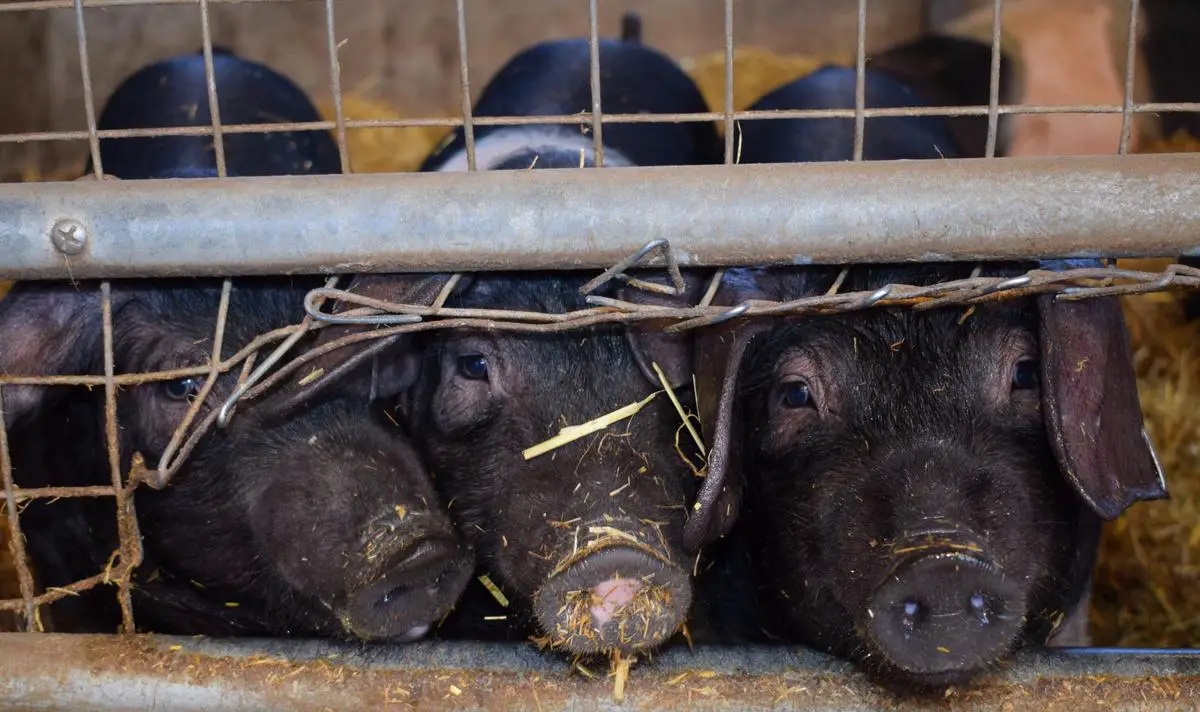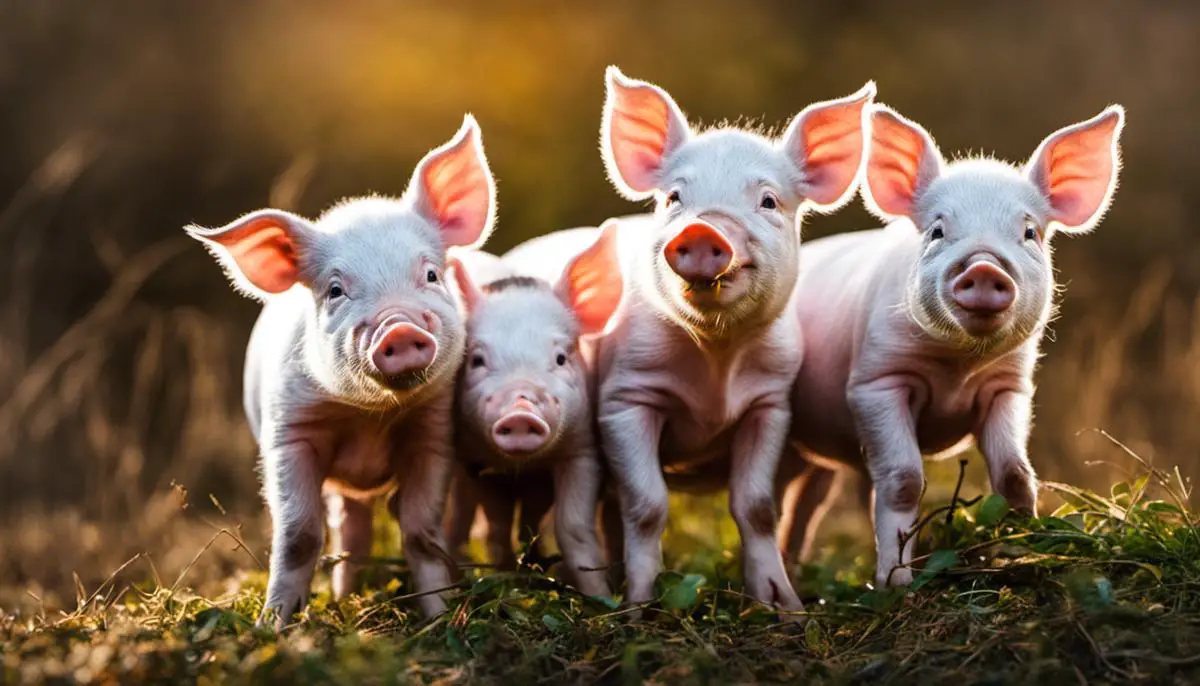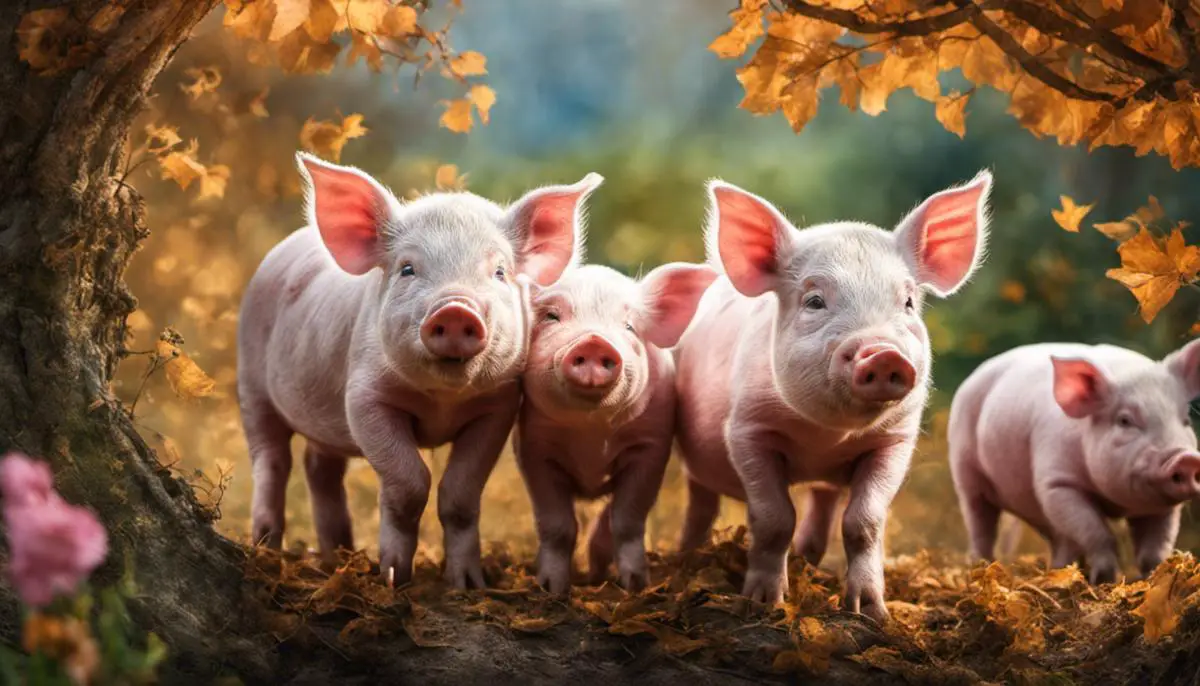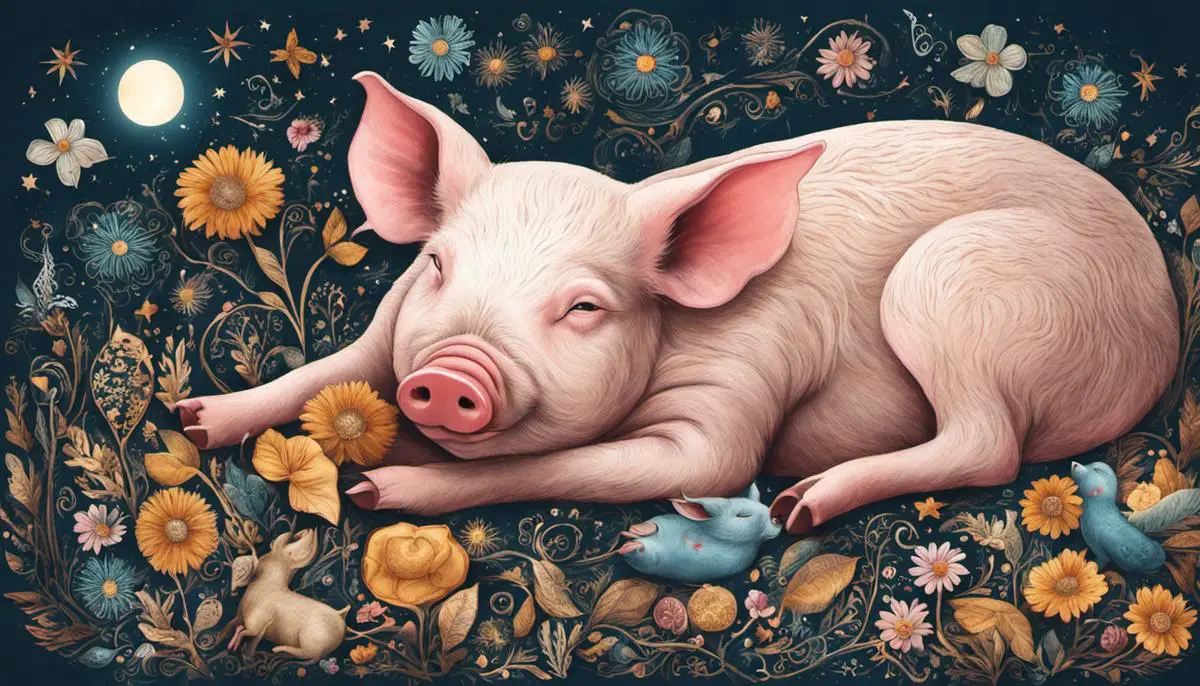In the realm of the subconscious, dreams weave narratives reflective of our life experiences, our hopes, and our fears. An often-overlooked aspect of dream analysis involves understanding the symbolic value and cultural context of specific elements within the dream, one of which are piglets. The exploration of piglet dream meaning requires a blended knowledge of dream interpretation basics, cultural symbology, psychology, and practical application.
The Basics of Dream Interpretation
Deep Dive into the Realm of Dream Interpretation: Fundamental Concepts and Theories
Often dismissed as intangible or whimsical, dreams remain enigmas to many. Those on the periphery may find it difficult to grapple with the highly abstract, amorphous, and unpredictable nature of dreams. However, within the realm of academia and scientific study, dream interpretation emanates as a profound stimulant for research, a further testament to the infinite allure of the human mind.
Dream interpretation broadly refers to the process of attributing meaning to dreams, an activity native to various cultures and epochs. In contemporary understanding, it is utilized in myriad disciplines including psychology, neurology, anthropology, to name just a few. Various theories and approaches originate from distinct civilizations and have evolved over centuries to form the knowledge base of contemporary dream interpretation.
One of the most influential concepts is the Psychoanalytic theory. Sigmund Freud, the founding father of Psychoanalysis, asserted that dreams are a reflection of repressed wishes, most prominently of a sexual nature. He noted that this repression often facilitated the conversion of latent thoughts into manifest dream content via the process of “dream-work,” inclusive of displacement, condensation, and symbol substitution. This theory draws from the innate human desire to fulfill unmet expectations and suppressed cravings.
Carl Jung, however, a colleague and critic of Freud, countered this theory with the idea of collective unconscious. He proposed the existence of archetypes – universally held symbols and patterns, surfacing in dreams from the collective unconscious. The broad array of symbols within dream content, according to Jung, were not individualized sexual projections but shared representations of human psychic material.
Contemporary theorists have painted a wider canvas, incorporating elements like cultural context and neurological firings into interpretations. The cognitive theory put forth by researchers such as Rosalind Cartwright suggests that dreams are a way for the brain to sort through emergent thoughts, feelings, and experiences to create significance and cognitive wholeness. This concept gives dreams a more active and dynamic role in cognitive functioning.
From an even more scientific perspective, Allan Hobson and Robert McCarley’s Activation-Synthesis Hypothesis lies upon neurological grounds. They propose that dreams are the brain’s way of making sense of random and erratic neural firing during REM sleep. This theory simplifies the often mystified conception of dreams in a biological context.
The landscape of dream interpretation is vast and varied, surging from ancient civilizations unto the modern thresholds of the subconscious. Its study stands testament to the infinite human curiosity and the relentless pursuit to understand the often unfathomable depths of the mind. From Freud to Jung, to Cartwright, to Hobson and McCarley, each theorist has added novel dimensions, shaping the field towards an exciting epoch of scientific inquiry. Dream interpretation reinforces the beautiful complexity mired into the human mind, enshrining the eternal pursuit of fathoming its depths – a testament to the mystic allure of existence.

Photo by sharonmccutcheon on Unsplash
Understanding Symbology of Pigs in Different Cultures
In the advancing scholarly frontier of dream interpretation, the abundant images of pigs—a seemingly mundane creature—warrant profound exploration. Varied cultures imbue pigs with a range of symbolic connotations, from prosperous auspiciousness to abject social taboo. This has been influenced by ecological, historical, and socio-cultural factors. An understanding of the significance of these swine motifs can expand our interpretation of dreams, as it provides a wider societal and cultural framework from which dream symbols derive their meanings.
In some Asian cultures, notably China, pigs are perceived as symbols of fortune, wealth and blessing. The pig is revered in the Chinese Zodiac, associated with traits such as honesty, kindness, and diligence. Dreams featuring pigs, in the context of this understanding, could be interpreted as an indication of forthcoming prosperity or the need for demonstrating the aforementioned virtues in waking life.
Contrarily, in the Abrahamic religions (Judaism, Christianity and Islam), pigs are usually considered unclean. This originates from strict dietary laws where consumption of pork is strenuously prohibited. In dreams, therefore, the appearance of pigs in cultures with such backgrounds might allude to forbidden temptations or a impending disharmony – a deviation from normative behaviours.
While the Hindu religion does not place much emphasis on pigs as objects of religious symbolism, the boar, an avatar of the deity Lord Vishnu, holds importance. The incarnation of the boar, Varaha, saved the Earth from a demon in Hindu mythology. Thus, among Hindu-oriented cultures, dreams of pigs may be interpreted as signs of protection or rescue from a perilous situation.
Among Native American communities, pigs, although not native to the continent, have intermingled with local culture owing to cross-cultural exchanges. Today, many tribes associate pigs largely with the embodiment of the universal life force – symbolizing abundance, fertility, and ferocity. Significantly, in dream interpretation, a pig can represent the life-giving force of the natural world and serve as a reminder of interconnectivity with nature.
In a testament to the geographic diversity of the world, how different cultures perceive pigs and the symbolic meanings they ascribe to them illustrate the dependent relationship between dreams and societal norms. Whether interpreted as prosperity, taboo, protective deity, or universal life force, pigs in dreams essentially serve as a cross-cultural lexicon of human values and societal constructs.
Clearly, to appreciate the depth of dream interpretation in its fullest capacity, it is essential to delve into its multi-disciplinary core that ropes in sociology, anthropology, religion, and psychology. Only then can we relatively grasp the diverse weave of symbolisms and meanings, such as the one carried by pigs across cultures, thereby contributing to the ever-developing landscape of dream study.

Photo by suzanne_tucker on Unsplash
The Psychological Framework of Piglets in Dreams
The inclusion of piglets in the province of dream symbolism offers an intriguing diversion from adult swine’s often headstrong symbolic representation. As they step into investigative limelight of sleep psychology and dream interpretation, their contributions to the rich tapestry of dream studies is intriguing.
In contrast to their fully grown counterparts often associated with abundance and prosperity – or conversely as repulse within various cultural contexts – piglets may insinuate infancy, purity, and innocence within a dream. Due to their young nature, piglets can constitute an emblem of potential and opportunities, decoded as an asseveration of latent growth and personal maturation.
Predominantly, these tender creatures bring forth notions tied to nurturing and care. Dreaming of piglets may resonate with themes of protective instincts, motherhood, or responsibility. Within the realm of dreams, interacting with piglets might imply one’s readiness or desire to nurture a burgeoning aspect of self or those around them.
Furthermore, the dynamic intersection between dream symbolism and animal behavior science establishes another perspective from which the piglet’s relevance in dream interpretation can be examined. Contrary to certain stereotypes, swine, particularly piglets, have been established to possess a high degree of intelligence, an attribute that parallels with human cognitive capacities in certain respects such as problem-solving and social structure. Hence, in dreams, piglets could mirror cognitive explorations, reflective thinking, or the necessity for astute judgments.
However, akin to the entire field of dream interpretation, understanding piglet symbolism could be analogous to navigating a labyrinth with multiple exits. Despite the existence of some generalities, deciphering dream-symbol meanings necessitates a consideration of dreamer’s personal experiences and cultural backgrounds. As piglets’ meaning can oscillate from one extreme of adoration in some cultures to repulsion in others, they become effective vehicles to inspect cross-cultural variations in dream analysis.
Moreover, the presence of piglets in dreams could implicitly serve as an inquiry into societal attitudes towards animals, acting as barometers of our communal values. They, thus, furnish a window to investigate how societal norms and attitudes get intricately woven into the dream content, thereby, illustrating the undulating confluence of personal experiences within the broader cultural milieu.
This variable and complex interpretation of piglets in dreams underscores the multi-layered phenomenon of dream symbolism. As scientific examination of their representation in dreams bridges the gap between psychology, neurology, and psychoanalysis, it opens a new avenue in dream studies. It hints at the enormity of knowledge still waiting to be unfolded, continuing the rewarding endeavor to plumb the depths of human consciousness.

Case Studies of Piglet Dream Interpretations
Diving deeper into the topic of dream interpretation, it seems important to fundamentally comprehend that deciphering these somnolent narratives is a complex, multi-dimensional process. Symbols in dreams are as intricate as they are fascinating; they have the potential to reflect our mind’s intriguing comprehension and segmentation of the external world. This article particularly concentrates on the metaphorical presence of piglets in dreams, their symbolic interpretations, and how such depictions vary in alignment with individual experiences, cultural backgrounds, and societal attitudes towards these creatures.
Piglets, often signifying infancy, purity, and innocence, are remarkably insightful symbols in dream parlance. Drawing parallels from piglets’ real-life attributes – such as their undeniable intelligence and remarkable cognitive abilities – it is evident that their appearance in the dreamscape might correlate to these very qualities. A dreamer may experience piglets in their dreams as a sign of burgeoning intellectual potential or impending opportunities that require them to utilize their intellect and cunning.
Moreover, piglets are often nurtured with care and affection in real life, symbolizing sheltered innocence or the need for care and compassion. Hence, their manifestation in dreams could represent the individual’s subconscious urging for care or reflection of their nurturing attitude. This could also hint towards an anticipated change that one might be unprepared for and requires nurturing.
The cultural context cannot be undermined in dream interpretation since our dreams often mimic our realities clouded with individual perceptions. The piglets’ symbolism extends to embody an individual’s perceptions influenced by their cultural affiliations and personal encounters. While certain cultures regard pigs and piglets as a sign of wealth and prosperity, others perceive them as unclean and taboo. Thus, the piglet’s dream could be an individual’s mind playing on their cultural beliefs or personal experiences, resonating in the symbolic representation of these animals.
In comparison to these cerebral interpretations stemming from psychology and psychoanalysis, some neurologically oriented theories such as the Activation-Synthesis Hypothesis would argue that these dreaming of piglets could be the brain’s quest in attributing meaning to random neural firing during REM sleep. However, a singular approach seems limiting as dream symbolism transcends neurological firings and delves into the intricate workings of subconscious mind, human cognition, and cultural impressions.
Reflecting on dreams of piglets intensifies the realization that they are not just adorable infant creatures; instead, they elicit a stream of perspectives based on cultural, individual and societal contexts. Understanding piglet dreams coalesces various aspects such as human consciousness, psychological insinuations and neurobiological processes – firmly signifying that dream interpretation is indeed a multi-layered and profound scientific endeavor. Conclusively, these piglet dreams are, hence, a manifestation of our intricate mind, its deep-seated thoughts, perceptions, and intricacies observed through a subtle lens of dreamy surrealism.

Application of Piglet Dream Interpretations
Applying the Symbolism of Piglets in Dreams to Psychotherapy and Self-Growth
As elucidated above, piglets’ symbolism encompasses aspects of infancy, purity, innocence, and undeveloped potential varying as per individuals’ experiences and cultural premises. Understanding the symbolism holds implications for psychotherapy and personal growth. By analyzing dreams featuring piglets, therapists can glean insights into a patient’s subconscious psyche, causing existing issues to surface and enabling targeted intervention.
Piglets, characterized by their infancy and vulnerability, often mirror hidden facets of one’s psyche. Dreaming of nurturing a piglet may reflect an innate desire to care for oneself or others. Consequently, piglet dreams can aid therapists in identifying unmet emotional needs, informing therapeutic approaches and empowering self-growth.
The innocence and purity attributes of piglets exist due to their infancy. When appearing in dreams, these symbols can allude to the dreamer’s present state of innocence being threatened or the need to reconnect with their pure, unaffected self in the face of adult complexities. Therapists can utilize this information to prompt patients to defend their innocence or retrieve their lost purity by combating stressful circumstances, thus fostering self-growth.
Moreover, piglets could personify potential or impending opportunities in dreams, reflecting the dreamer’s anticipation of unexplored ventures. Therapists thus gain access to the latent aspirations and fears of patients, which can be addressed by employing Jung’s principle of Individuation. Guiding patients to identify, accept, and integrate these unfathomed aspects into their conscious personality can accelerate personal development.
Similarly, the intelligent nature attributed to piglets provides insights into the dreamer’s cognitive processes. Therapists can identify intelligence-related insecurities or unrealized potential in individuals, aligning therapeutic mechanisms to boost self-confidence and cognitive development.
Therefore, deciphering dreams that comprise piglet symbolism presents a nexus of psychological, neurological, and psychoanalytical insights that provide fertile grounds for therapists. Piglet dreams can be viewed as the dreamer’s unique narrative about ambitions, fears, and suppressed emotions. Dream interpretation hence emerges as an indispensable tool in the therapist’s kit, extending into arenas of personal growth and self-fulfillment.
Moreover, a culturally sensitive lens becomes vital when interpreting piglet dreams, allowing therapists to respect and honor an individual’s cultural beliefs and experiences. Acknowledging these variations can lead to more personalized therapeutic interventions, improving the treatment’s efficacy and fostering patients’ self-growth.
In the realm of neuroscience, piglets in dreams, much like all dream content, can be construed as the mind’s mechanism of managing random neural firings during REM sleep, as per the Activation-Synthesis Hypothesis. Yet, the very human propensity to seek meaning often overlays these arbitrary constructions with symbolic interpretations, intertwining cognitive functioning with psychoanalytic constructs.
While Activation-Synthesis and other neurologically-oriented theories offer substantial understanding into the physiological aspect of dreaming, they might fall short when decoding individual-specific intricacies inherent to the symbolism of piglets in dreams. Relying solely on a singular approach can limit the interpretation, understating the symbolism’s nuanced layers and implications for psychotherapy and personal growth.
Therefore, merging human consciousness’s psychological depth, the symbolic vocabulary of psychoanalysis, and the rationality of neurobiological processes can offer a well-rounded, holistic perspective in interpreting piglet dreams. Recognizing dreams as manifestations of the human mind’s intricate tapestry reiterates the immense potential of dream studies in psychotherapy and self-growth, cultivating a deeper appreciation for this profound, multi-layered scientific endeavor.

The thought-provoking complexity of dream interpretation reveals the profound potential dreams possess, acting as mirrors to our subconscious. The understanding gained from deciphering dreams involving piglets solidifies this concept. Not only do these interpretations equip us with the ability to better comprehend our own psyche, but they also empower us to initiate significant changes for our personal and psychological growth. Indeed, the exploration of piglet dream meanings is an extolment to the richness of our dreams, and a reminder of the infinite learning they offer.
